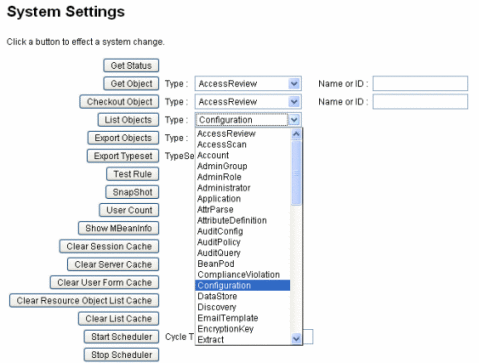 To Modify the ErrorUIConfig Object:
To Modify the ErrorUIConfig Object:
-
Log in to Waveset Administrator interface.
-
Open the System Settings page by typing http:// host:port/idm/debug in to your browser.
-
Locate the Type menu, located next to the List Objects button. Choose Configuration from the menu.
Figure 6–3 List Objects Type Menu

-
Click the List Objects button.
-
On the List Objects of type: Configuration page, click the ErrorUIConfig edit link.
The following example shows the XML for an ErrorUIConfig object on Checkout Object: Configuration page:
<?xml version=’1.0’ encoding=’UTF-8’?> <!DOCTYPE Configuration PUBLIC ’waveset.dtd’ ’waveset.dtd’> <!-- MemberObjectGroups="#ID#Top" extensionClass="GenericObject" id="#ID#9787BA467E01441B:178655:1156195C008:-7FFE" lastModifier="com.waveset.object.ErrorUIConfig" name="ErrorUIConfig"--> <Configuration id=’#ID#9787BA467E01441B:178655:1156195C008:-7FFE’ name=’ErrorUIConfig’ lock=’Configurator#1200600790328’ creator=’com.waveset.object.ErrorUIConfig’ createDate=’1191343145328’ lastModifier=’com.waveset.object.ErrorUIConfig’ lastModDate=’1191343145328’> <Extension> <Object> <Attribute name=’Enabled’> <Boolean>true</Boolean> </Attribute> <Attribute name=’ErrorMsgID’ value=’UI_ERROR_DEFAULT_FATAL_MESSAGE’/> </Object> </Extension> <MemberObjectGroups> <ObjectRef type=’ObjectGroup’ id=’#ID#Top’ name=’Top’/> </MemberObjectGroups> </Configuration> -
Modify the ErrorUIConfig object attributes as needed.
You can modify any of the following attributes:
-
Enabled. Controls whether the message is enabled (true) or disabled (false).
Note –The ability to disable this attribute is provided for backward-compatibility; however, disabling this attribute will result in cryptic messages and you will not see the typical extended messages in the System Log.
-
ErrorMsgID. Identifies the error message to be displayed.
Change the ErrorMsgID attribute value to provide the message text you want displayed.
The current setting for this attribute is as follows, and it references the UI_ERROR_DEFAULT_FATAL_MESSAGE message in the message catalog:
<Attribute name=’ErrorMsgID’ value=’UI_ERROR_DEFAULT_FATAL_MESSAGE’/>
Note –If you are using parameterized messages with single or double quotes in the message, you must use an additional single or double quote to escape the message. (You will see only one quote symbol when the message is output to the system.)
For example, the following message begins and ends with two single quote marks:
”’{0}’’
-
-
When you are finished, click Save to save your changes.
Note –If you have difficulty creating a default error message, contact your Administrator or Administrator hotline.
- © 2010, Oracle Corporation and/or its affiliates
